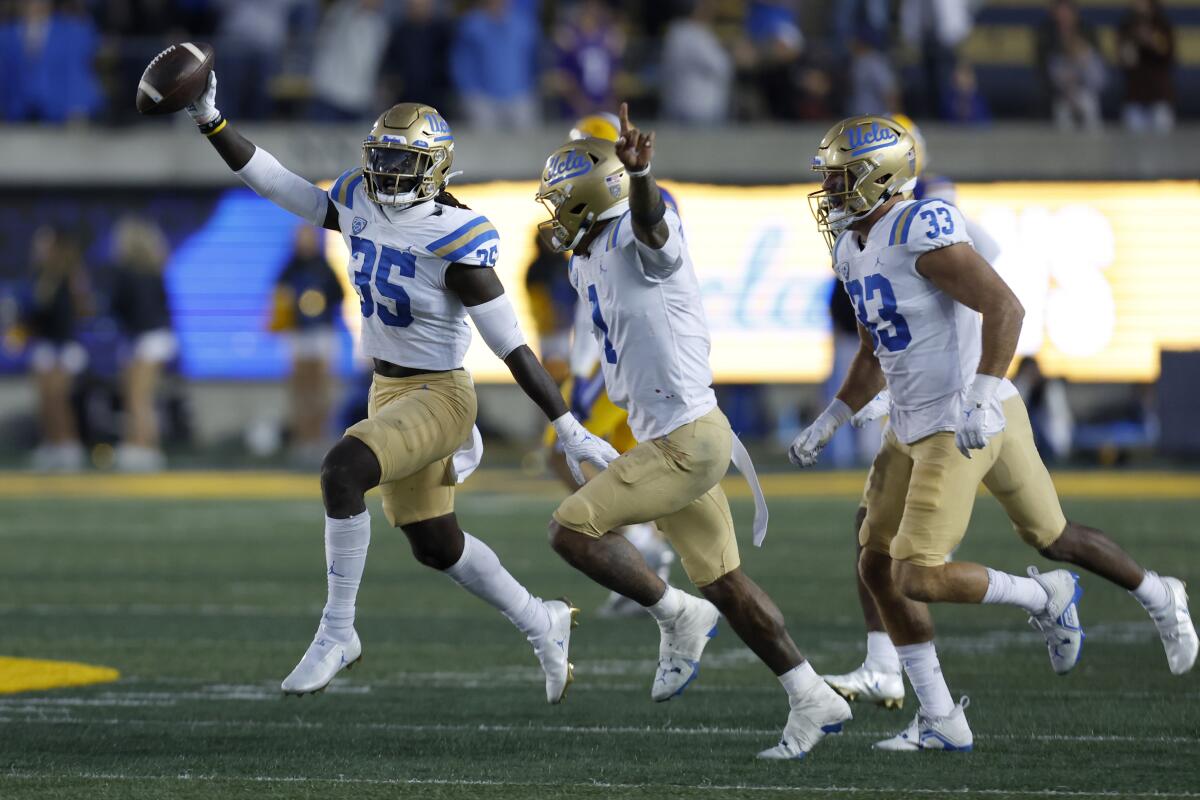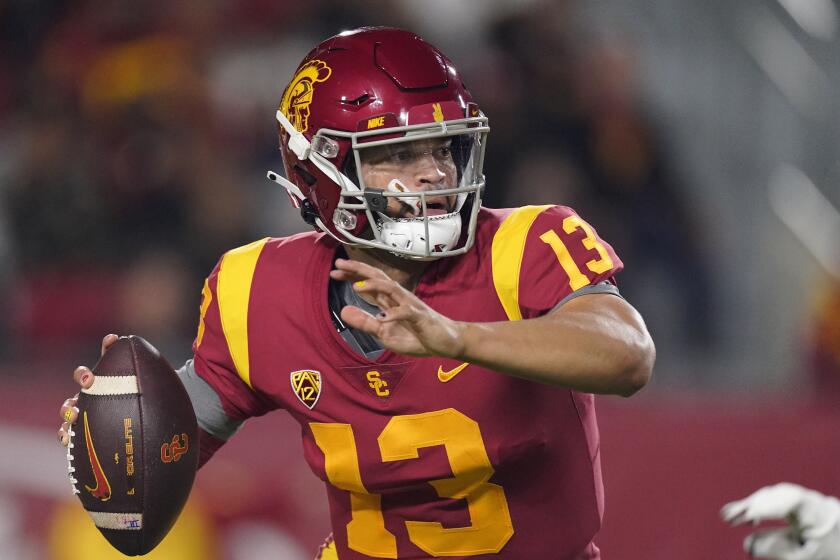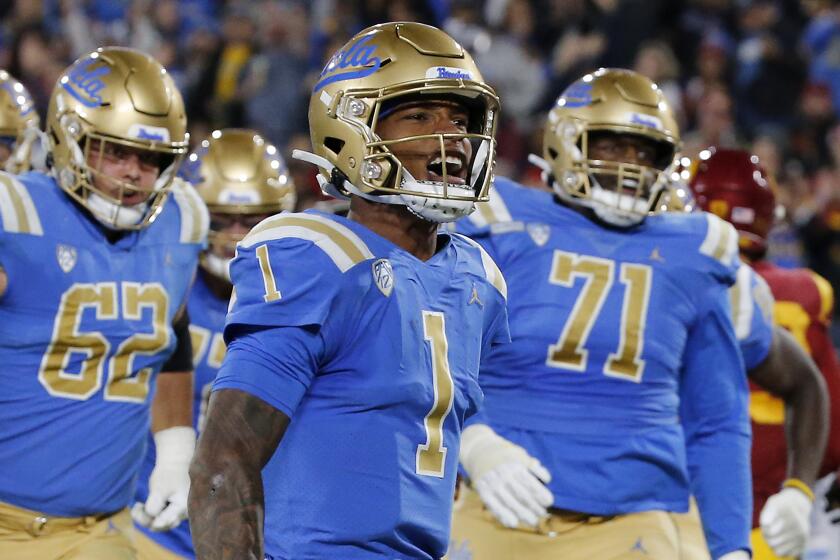Op-Ed: UCLA rushes for the Big Ten and the big payday. But what about the players?

Big Ten football means something in the national psyche. Itâs the Midwest. Itâs Frigidaire-snowy Saturdays after a crisp fall. Itâs teams defined by tough running games and rounded shoulders. One thing it is not and has never been is a coastal operation of golden beaches and year-round sunshine.
And yet, here is UCLA, planning to abandon the Pac-12 conference and join the Big Ten, following a vote from the University of California Board of Regents next week. Opponents of the move are hoping to block it; they will almost certainly lose.
They will lose because this is not about a sports tradition or weather patterns. This is about big business and treating our college campuses as settings for in-demand entertainment and only incidentally places where students happen to attend classes. This is about cold hard cash.
(USC is also moving to the Big Ten, which is similarly silly and craven, but as a private institution, USC does not have to go through a state board to make it a reality.)
USC quarterback Caleb Williams suffered a significant hamstring injury during the Pac-12 title game, but he still hopes to play in the Cotton Bowl.
With the addition of the Southern California teams, the Big Tenâs new media deal is expected to bring in roughly $100 million annually for each of its 16 member schools, far outpacing the $31 million that the current Pac-12âs television deal promises.
Boosters of the UCLA switch say this money is desperately needed or the university may have to cut sports teams. The schoolâs athletic department posted an unheard of $62.5-million budget shortfall for fiscal 2021, and a three-year deficit of more than $100 million.
The department blames its disastrous ledger sheet on the pandemic, the elimination of home football games in 2020, and losing a lucrative deal with Under Armour in which the schoolâs athletes were walking billboards for the company.
Interestingly, when it comes to UCLA budgeting, cutting coaching salaries, including football coach Chip Kellyâs latest four-year $23-million deal or hoops coach Mike Croninâs six-year, $24.5-million contract never seems to be up for discussion.
And with Big Ten money about to flow into the schoolâs coffers, making everyone who doesnât actually play a nice chunk of change, the toll on the players is also going underdiscussed. In effect, the plan is to treat UCLAâs 18-to 22-year-old student athletes as fungible material in the manufacture of money.
The players will have to travel a great deal more throughout the season once UCLA moves to the Big Ten. Their flight schedule will be comparable to a pro team, but charter airfareâs not the only price players and the schools will have to pay.
Figures presented at the UC Board of Regents meeting in November indicated that as much as $10 million will need to be spent on more academic advisors to travel with the team, more mental health therapists to get them through the rigors of the new schedule, and in addition to that, the program will also allocate â$252,000 for education, preventative measures and direct psychiatric care to help with sleep, eating disorders, substance abuse and other acute care.â
It remains to be seen if UCLA stars Dorian Thompson-Robinson and Zach Charbonnet will play against Pittsburgh in the Sun Bowl on Dec. 30.
These figures are cited as financial costs instead of social costs, to the shame of all parties involved: The nine-figure payday at the end of the rainbow will be offset only a bit by the risks to the academic and mental health of the players the adults are supposedly there to safeguard.
Iâm reminded of the words of former college basketball player Laron Profit who told me, âWeâre not student athletes. We are athlete students because the moment we are on campus, it is made clear to us what our priorities are supposed to be.â
At UCLA, those priorities are now crystal clear, and they argue for treating the Bruin players like the employees they are, with a salary and healthcare benefits.
I once asked a prominent college football coach about paying athletes in the revenue-producing college sports, especially football and basketball. He answered that there was value in the âpurityâ of amateurism, in the role of the student athlete. Paying players would sully that special experience.
I followed up by asking why his team, historically in the Atlantic Coast Conference, planned to blow up the purity of its history by moving to â yes â the Big Ten. His response was, âThis is big business and sometimes big businesses must restructure to survive.â
So are we talking warm and fuzzy amateurism or cutthroat big business?
Many college coaches hold this kind of duality in their heads: College sports is amateurism/college sports is business. It is obvious which one of those statements is the truth and which at best is a self-delusion.
Treat UCLA players like the workers they are, or donât expect them to travel the country performing in the name of paying the salaries of administrators and coaches. Donât destroy traditions â or âstudent athletesâ â in the name of the bottom line.
Dave Zirin is the sports editor of the Nation and author of âThe Kaepernick Effect.â
More to Read
A cure for the common opinion
Get thought-provoking perspectives with our weekly newsletter.
You may occasionally receive promotional content from the Los Angeles Times.












